An article from University of Oslo

People with a rheumatic disease labelled as lazy
Pain and chronic fatigue frequently go hand in hand. In such cases it does not help to ask patients to put on their training shoes and start exercising, according to a professor who has been conducting research on Sjögren’s syndrome.
Denne artikkelen er over ti år gammel og kan inneholde utdatert informasjon.
“It’s inexplicable‒ I never know when this overpowering fatigue will strike. Suddenly it’s as though my battery has run out. But when I tell others about it, they tend to say, well, it’s very normal to be tired. Healthcare personnel aren’t particularly understanding about it either.”
This is how one person with Sjögren’s syndrome describes her experience of abnormal or chronic tiredness, or fatigue ‒ a tiredness that strikes abruptly and unexpectedly, for example when you suddenly fall asleep over the breakfast table.
Professor Anne Marit Mengshoel of the Institute of Health and Society at the University of Oslo has examined how this overwhelming tiredness develops in patients with Sjögren’s syndrome.
She has primarily been concerned with their narratives of experiences with abnormal tiredness, and how it affects their daily lives.
The fitness culture has gone too far

She finds, among other things, that many of those whom she interviewed felt they were not taken seriously by healthcare personnel. They generally found little understanding of how challenging it is to live with this syndrome. Some were given the message “to get on with life as well as you can”.
Others felt that they were labelled as lazy. It was not uncommon for them to be encouraged to put their training shoes on, get out and exercise.
“I think the Norwegian fitness culture has gone too far in painting a picture of physical activity as a panacea, whatever the situation. This is a disease which varies, and there are days when sufferers are too ill to exercise. The patients need understanding and acceptance from healthcare personnel and ordinary people that they may need a little time-out, and that how they feel varies from day to day,” Mengshoel tells us.
Not just normal tiredness
The research project is based on qualitative interviews with five women and four men aged between 27 and 67 years.
There is currently a dearth of knowledge about the consequences for those who are affected by this abnormal tiredness, and nor are there any good Norwegian words for the English word “fatigue”.
Mengshoel found, however, that patients experienced their fatigue as something inexplicable, and were poorly informed of the fact that this is something which often accompanies the disease. When she asked how they functioned in daily life, on the other hand, it emerged clearly that it was not a case of normal tiredness.
“They spoke of a kind of unpredictable fatigue that could vary from one day to the next. Occasionally it was so pronounced that they felt paralysed,” Mengshoel says.
Also relevant to other patient groups
In the field of rheumatology, researchers have been more concerned with pain than fatigue.
While there has been some research on abnormal tiredness in other disease groups in the last twenty years, particularly among cancer patients, the research has seldom investigated the daily lives of patients, as Mengshoel has done.
“In a quantitative study it is easy to say that ‘so and so many patients have these symptoms’, without describing what this implies for them. The strength of qualitative studies is that the manner in which abnormal tiredness is experienced by those whom it affects emerges clearly,” says Johan K. Stanghelle, research director at Sunnaas Rehabilitation Hospital.
Stanghelle has carried out research into abnormal tiredness in connection with several diseases, particularly post-polio syndrome. He recognizes the descriptions given by patients with Sjögren’s syndrome.
“I don’t think this is specific to Sjögren’s syndrome; the study provides a very good description of the phenomenon of abnormal tiredness which patients with other diseases can relate to.
Between 65 and 70 percent of Sjögren’s syndrome sufferers experience fatigue, a proportion which Stanghelle does not believe sets them apart especially from others with chronic diseases. Pain and abnormal tiredness go hand in hand. Studies of patients with other chronic disorders reveal that those who report high pain scores report similarly high scores for tiredness.
Easier to dismiss
Stanghelle believes that recognition has gradually dawned in the health services that abnormal tiredness arises from and accompanies a number of diseases, but not what it implies.
“The fact that there is no clear explanation for how and why it occurs, and no drugs or other specific treatment, makes the problem easier to dismiss or disregard. I hope that a study such as this can enable the health services to open their eyes to the enormous consequences it has for those affected,” Stanghelle says.
He advocates for a greater focus on advice to patients about what they can do when fatigue strikes them, and for workplace adaptation.
Many unanswered questions
But where does this fatigue come from? Does it come about because of the disease itself, or is it an adverse effect of the drugs? What is actually occurring in the body? Is there a form of fatigue that is exclusive to each disease group?
Various hypotheses are put forward with regard to this.
“In post-polio syndrome, for example, researchers have concerned themselves with the idea of an attack on the fatigue centre of the brain, as part of the infection itself. However, this has not been confirmed,” Stanghelle tells us.
Mengshoel’s study has not addressed causal factors such as these. The researchers do not yet know what happens physically in the body, but what they do know is that abnormal tiredness is quite distinct from normal tiredness; it leads to a long-term lack of energy and varies in an uncontrollable and unpredictable way.
Mengshoel hopes to be able to involve more medical specialists, such as those involved in brain research, in possible future projects to examine how fatigue is described and may be explained for several disease groups.


































